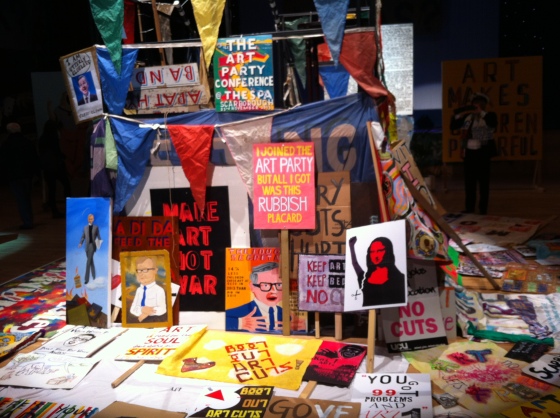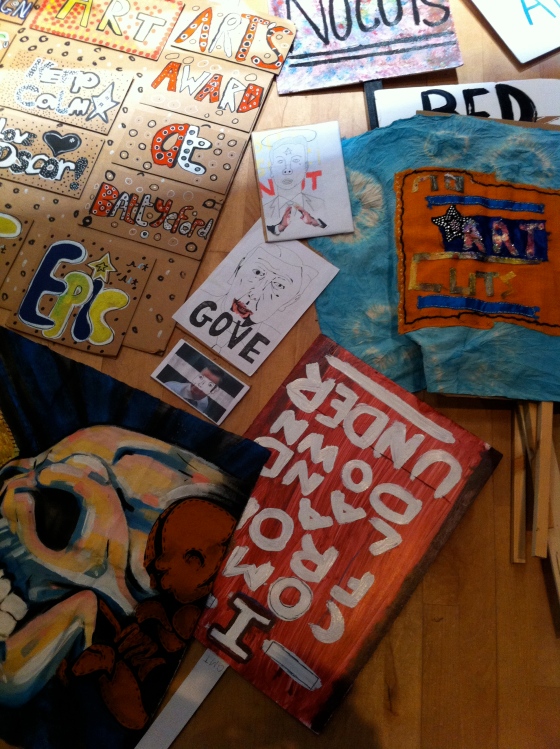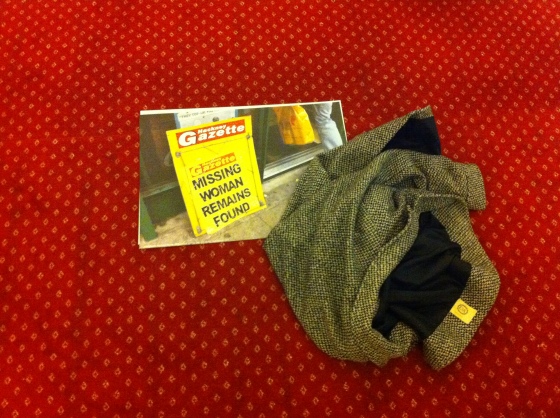The Art Party Conference was always going to be a lot of fun, not least because of the delightfully irreverent call for attendees to create portraits of Michael Gove. These were the best-looking protest banners I’ve ever seen, a colourful exercise in the democratic right to say what you think humorously, and often very beautifully. Most were funny, some were a bit mean, but they all conveyed artists and art practitioners’ righteous anger at the downgrading of the arts in education – and the impact this will have ongoing.
The day-long event at the Spa Centre, Scarborough was organised by artist Bob and Roberta Smith, whose outsized flags you might have seen on the Southbank over the summer. He was so outraged by the impact of Michael Gove’s educational reforms on the arts that he made a painting called Letter To Michael Gove. This became a singularity which, when expanded, became The Art Party Conference: a gathering of art teachers, kids, curious locals and artists including Jeremy Deller, Cornelia Parker and Richard Wentworth for a day of curious actions on the north eastern coast of England.
In a room looking onto the steel-grey sea there was an impromptu opportunity to do life drawing of surfers with easels and paper already in place. Around the corner, there was a Michael Gove lookalike in a bad suit, pushing his way irritatedly through the crowds at the Goveshy where crowds lined up to chuck stuff at the (beautiful, hand-crafted) plaster busts of the Secretary Of State For Education. Up the stairs, nestled in a corner was a nail bar where you could have images of iconic female artists applied to your nails and where the real art was in the conversation that the artist was curating between nail technician and recipient. There were all kinds of transactions going on and very few involved handing over cash. You paid your fiver entrance and everything was free, bar the normal commercial transactions of tea and bowls of chips that reminded you that we were indeed at a conference centre. Plates of home-made chewy cookies and lollipops were freely available on artists stands, alongside beautifully-printer A2 posters from Pavel Büchler, Ian Bourne and Bobby Baker. We were citizens in the free state of the Art Party and it felt like a participatory version of Carry On Up The Situationists.
It was also neatly democratic. We went up to see what was happening with Roger Clarke’s Record Player Orchestra and ended up doing our own performance which involved choosing a tone on a record and playing it whenever you wanted along with nine other people doing the same thing. It was strangely comforting, the hum of electricity and the drone sending us all into somnambulance. This also led to another discovery: spending an hour playing pure frequency makes your eyeballs buzz.
And finally, we stumbled upon curator Lynda Morris’s talk, titled Drinking With Gilbert and George. This was a real highlight and could be compressed into ‘we got drunk/ we made art’. She finished her talk with a hearty ‘cheers!’ and played out the pair’s singing sculpture, which became our theme tune as we wended a happy way back the Travelodge, which like everything else, now looked like a piece of art.
















08
Jun
Exiting the news purdah
A month ago today I saw the exit poll results and turned the news off. I haven’t turned it on again.
I’d embarked on an unplanned news black out. I stopped watching TV and I avoided Question Time, which is really just a middle class version of Jeremy Kyle anyway. I stopped listening to the radio, apart from Radio 3, which only has news once an hour and pirate radio, which has news never.
What’s done was done and it was going to be bad for anyone unlucky enough to be poor or incapable. There was nothing I could do about it, so I switched off.
Social media was also off the agenda, because I knew that most people I knew would be raging into the echo chamber of Facebook and Twitter and that felt disheartening and pointless. I averted my eyes from free newspapers when I was working in town and avoided conversations about politics.
Some news filtered through early, mostly from the far-off land of my teenage son, but mostly I spent the last month vacuum-packed, protected from unsightly post-result posturing and jostling. I only found out Michael Gove was Justice Secretary last week and immediately wished I hadn’t.
My news blackout posed an interesting question: what happens when you’re not being enraged and distracted by the minutia of the daily news grid?
The answer is that unsurprisingly, it gives you back a lot of time. It also focuses the mind on what you can do rather than what you can’t. Cabinet ministers waft into the distance when you don’t see them every day, remote and shapeless as smoke, and local problems pop into focus in their place.
The last month of national radio silence has made me want to connect locally. The main thing now is rediscovering our individual and collective impulse to do it ourselves, to find opportunities to volunteer, and to strengthen ties with the communities we’re already part of through location or background or interests. We need to make alliances outside of our usual friends and family. And then, who knows what might emerge?
We don’t have the same collective impulse as Spain, which makes it harder for a phenomenon like Podemos to occur, but we do have a long-established tradition of DIY culture. If the mainstream isn’t providing, we’ve filled the gap with grassroots responses, whether that’s pirate radio or punk. We’ve also, thanks to a useful bit of local democracy, now got new neighbourhood forums that give communities legal rights and powers to shape new developments.
So that’s what I’m saying: DIY and do it local – and don’t let the news distract you.
Image: Jon S
Share this:
9 years ago Short URL Comments
social commentary/Uncategorized
a month on from the election/DIY/election/election result/national politics/neighbourhood forums/news/Pirate Radio/podemos/punk/purdah